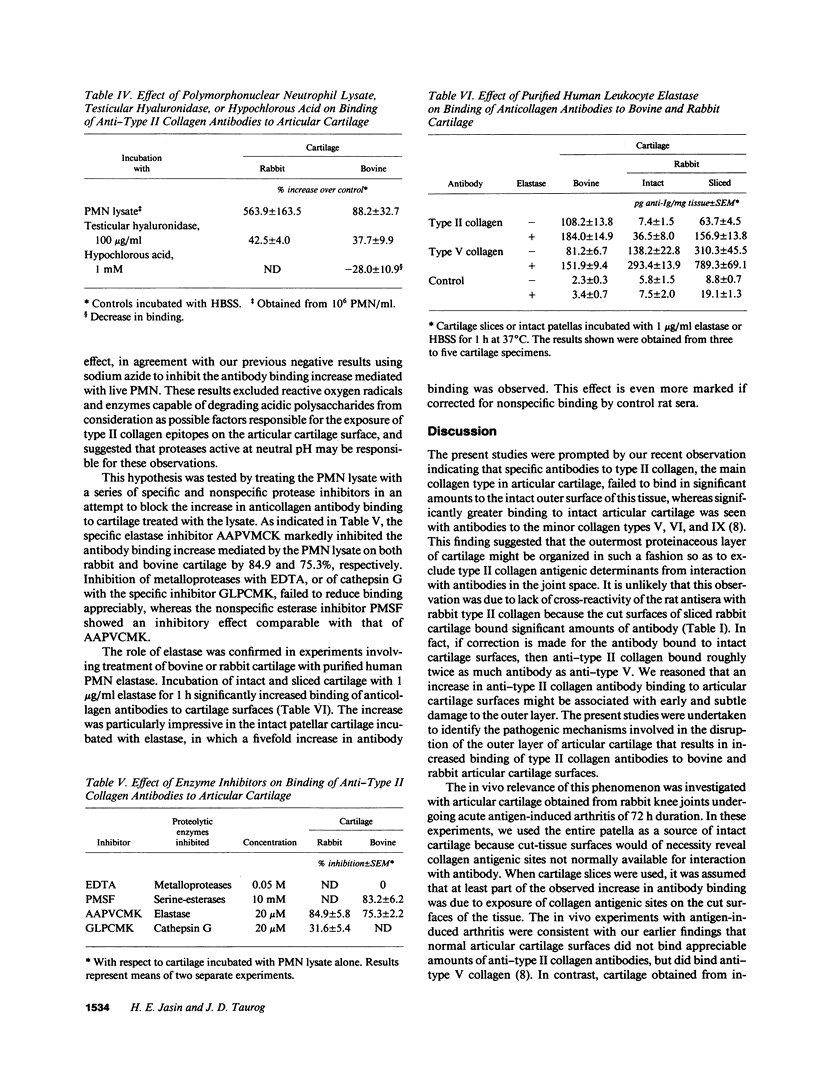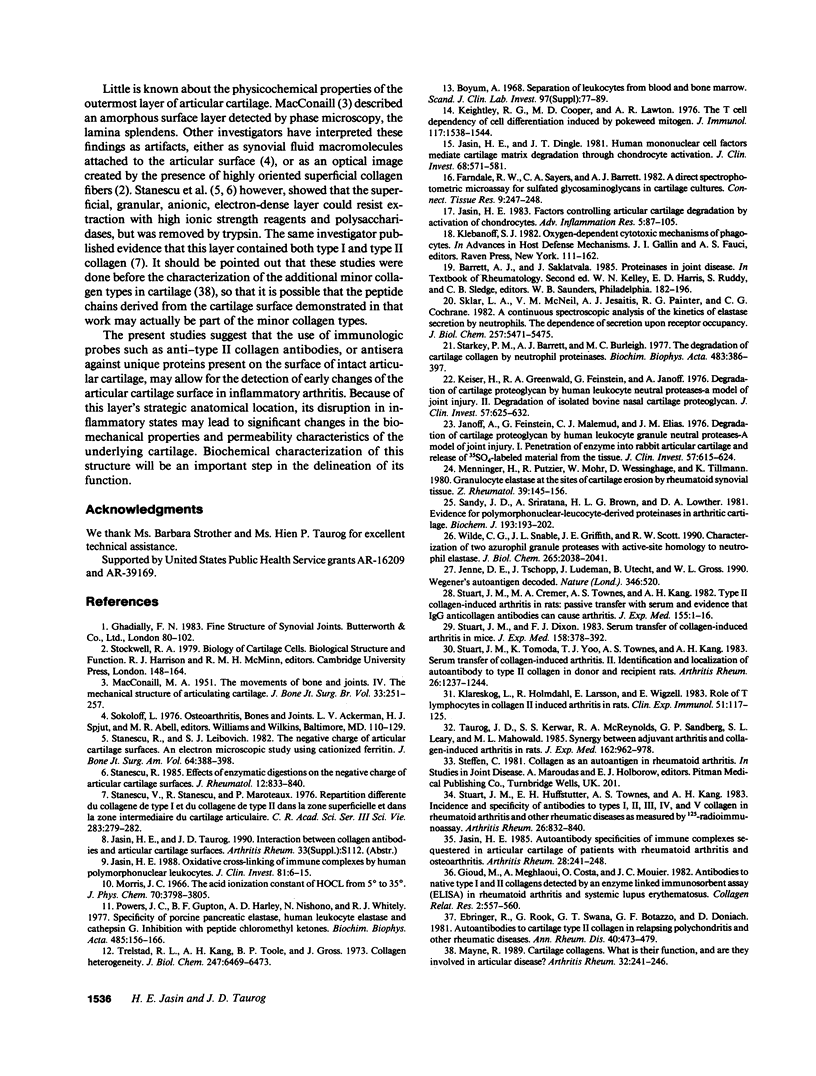Abstract
We recently observed that specific antibodies to type II collagen do not bind in appreciable amounts to the intact surface of articular cartilage, whereas antibodies to the minor collagen types V, VI, and IX do. These results suggest that the outermost cartilage surface layer prevented interaction of the antibodies with the major collagen type in articular cartilage. The present studies were designed to investigate the pathogenic mechanisms involved in the disruption of the cartilage surface layer in inflammatory arthritis. Articular cartilage obtained from rabbits undergoing acute antigen-induced arthritis of 72 h duration showed a significant increase in binding of anti-type II antibody to cartilage surfaces compared with normal control cartilage (P less than 0.01). Augmentation of anti-type II binding was also observed upon in vitro incubation of bovine articular slices or intact rabbit patellar cartilage for 1 h with human polymorphonuclear neutrophils (PMN), PMN lysates, or purified human PMN elastase. This increase was not inhibited by sodium azide, nor was it enhanced by incubation of cartilage with the strong oxidant hypochlorous acid. Chondrocyte-mediated matrix proteoglycan degradation in cartilage explants cultured in the presence of cytokines failed to increase antibody binding appreciably. The augmentation in antibody binding seen with PMN lysates was inhibited by the nonspecific serine-esterase inhibitor PMSF, but not by the divalent metal chelator EDTA. The elastase-specific inhibitor AAPVCMK also inhibited most of the PMN-induced increase in antibody binding, whereas the cathepsin G-specific inhibitor GLPCMK was much less effective. Incubation of intact cartilage with purified human PMN elastase indicated that this serine esterase could account for the increase in anti-type II collagen antibody binding to intact cartilage surfaces. These studies suggest that in an inflammatory response, PMN-derived elastase degrades the outer layer of articular cartilage, exposing epitopes on type II collagen. They also help clarify the pathogenic mechanisms involved in early articular cartilage damage in inflammatory joint diseases.
Full text
PDF





Selected References
These references are in PubMed. This may not be the complete list of references from this article.
- Ebringer R., Rook G., Swana G. T., Bottazzo G. F., Doniach D. Autoantibodies to cartilage and type II collagen in relapsing polychondritis and other rheumatic diseases. Ann Rheum Dis. 1981 Oct;40(5):473–479. doi: 10.1136/ard.40.5.473. [DOI] [PMC free article] [PubMed] [Google Scholar]
- Farndale R. W., Sayers C. A., Barrett A. J. A direct spectrophotometric microassay for sulfated glycosaminoglycans in cartilage cultures. Connect Tissue Res. 1982;9(4):247–248. doi: 10.3109/03008208209160269. [DOI] [PubMed] [Google Scholar]
- Gioud M., Meghlaoui A., Costa O., Monier J. C. Antibodies to native type I and II collagens detected by an enzyme linked immunosorbent assay (ELISA) in rheumatoid arthritis and systemic lupus erythematosus. Coll Relat Res. 1982 Nov;2(6):557–564. doi: 10.1016/s0174-173x(82)80009-5. [DOI] [PubMed] [Google Scholar]
- Janoff A., Feinstein G., Malemud C. J., Elias J. M. Degradation of cartilage proteoglycan by human leukocyte granule neutral proteases--a model of joint injury. I. Penetration of enzyme into rabbit articular cartilage and release of 35SO4-labeled material from the tissue. J Clin Invest. 1976 Mar;57(3):615–624. doi: 10.1172/JCI108317. [DOI] [PMC free article] [PubMed] [Google Scholar]
- Jasin H. E. Autoantibody specificities of immune complexes sequestered in articular cartilage of patients with rheumatoid arthritis and osteoarthritis. Arthritis Rheum. 1985 Mar;28(3):241–248. doi: 10.1002/art.1780280302. [DOI] [PubMed] [Google Scholar]
- Jasin H. E., Dingle J. T. Human mononuclear cell factors mediate cartilage matrix degradation through chondrocyte activation. J Clin Invest. 1981 Sep;68(3):571–581. doi: 10.1172/JCI110290. [DOI] [PMC free article] [PubMed] [Google Scholar]
- Jasin H. E. Oxidative cross-linking of immune complexes by human polymorphonuclear leukocytes. J Clin Invest. 1988 Jan;81(1):6–15. doi: 10.1172/JCI113310. [DOI] [PMC free article] [PubMed] [Google Scholar]
- Jenne D. E., Tschopp J., Lüdemann J., Utecht B., Gross W. L. Wegener's autoantigen decoded. Nature. 1990 Aug 9;346(6284):520–520. doi: 10.1038/346520a0. [DOI] [PubMed] [Google Scholar]
- Keightley R. G., Cooper M. D., Lawton A. R. The T cell dependence of B cell differentiation induced by pokeweed mitogen. J Immunol. 1976 Nov;117(5 Pt 1):1538–1544. [PubMed] [Google Scholar]
- Keiser H., Greenwald R. A., Feinstein G., Janoff A. Degradation of cartilage proteoglycan by human leukocyte granule neutral proteases--a model of joint injury. II. Degradation of isolated bovine nasal cartilage proteoglycan. J Clin Invest. 1976 Mar;57(3):625–632. doi: 10.1172/JCI108318. [DOI] [PMC free article] [PubMed] [Google Scholar]
- Klareskog L., Holmdahl R., Larsson E., Wigzell H. Role of T lymphocytes in collagen II induced arthritis in rats. Clin Exp Immunol. 1983 Jan;51(1):117–125. [PMC free article] [PubMed] [Google Scholar]
- MacCONAILL M. A. The movements of bones and joints; the mechanical structure of articulating cartilage. J Bone Joint Surg Br. 1951 May;33B(2):251–257. [PubMed] [Google Scholar]
- Mayne R. Cartilage collagens. What is their function, and are they involved in articular disease? Arthritis Rheum. 1989 Mar;32(3):241–246. doi: 10.1002/anr.1780320302. [DOI] [PubMed] [Google Scholar]
- Menninger H., Putzier R., Mohr W., Wessinghage D., Tillmann K. Granulocyte elastase at the site of cartilage erosion by rheumatoid synovial tissue. Z Rheumatol. 1980 May-Jun;39(5-6):145–156. [PubMed] [Google Scholar]
- Powers J. C., Gupton B. F., Harley A. D., Nishino N., Whitley R. J. Specificity of porcine pancreatic elastase, human leukocyte elastase and cathepsin G. Inhibition with peptide chloromethyl ketones. Biochim Biophys Acta. 1977 Nov 23;485(1):156–166. doi: 10.1016/0005-2744(77)90203-0. [DOI] [PubMed] [Google Scholar]
- Sandy J. D., Sriratana A., Brown H. L., Lowther D. A. Evidence for polymorphonuclear-leucocyte-derived proteinases in arthritic cartilage. Biochem J. 1981 Jan 1;193(1):193–202. doi: 10.1042/bj1930193. [DOI] [PMC free article] [PubMed] [Google Scholar]
- Sklar L. A., McNeil V. M., Jesaitis A. J., Painter R. G., Cochrane C. G. A continuous, spectroscopic analysis of the kinetics of elastase secretion by neutrophils. The dependence of secretion upon receptor occupancy. J Biol Chem. 1982 May 25;257(10):5471–5475. [PubMed] [Google Scholar]
- Stanescu R. Effects of enzymatic digestions on the negative charge of articular cartilage surfaces. J Rheumatol. 1985 Oct;12(5):833–840. [PubMed] [Google Scholar]
- Stanescu R., Leibovich S. J. The negative charge of articular cartilage surfaces. An electron microscopic study using cationized ferritin. J Bone Joint Surg Am. 1982 Mar;64(3):388–398. [PubMed] [Google Scholar]
- Stanescu V., Stanescu R., Maroteaux P. Répartition différente du collagene de type I et du collagène de type II dans la zone superficielle et dans la zone intermédiaire du cartilage articulaire. C R Acad Sci Hebd Seances Acad Sci D. 1976 Jul 19;283(3):279–282. [PubMed] [Google Scholar]
- Starkey P. M., Barrett A. J., Burleigh M. C. The degradation of articular collagen by neutrophil proteinases. Biochim Biophys Acta. 1977 Aug 11;483(2):386–397. doi: 10.1016/0005-2744(77)90066-3. [DOI] [PubMed] [Google Scholar]
- Stuart J. M., Cremer M. A., Townes A. S., Kang A. H. Type II collagen-induced arthritis in rats. Passive transfer with serum and evidence that IgG anticollagen antibodies can cause arthritis. J Exp Med. 1982 Jan 1;155(1):1–16. doi: 10.1084/jem.155.1.1. [DOI] [PMC free article] [PubMed] [Google Scholar]
- Stuart J. M., Dixon F. J. Serum transfer of collagen-induced arthritis in mice. J Exp Med. 1983 Aug 1;158(2):378–392. doi: 10.1084/jem.158.2.378. [DOI] [PMC free article] [PubMed] [Google Scholar]
- Stuart J. M., Huffstutter E. H., Townes A. S., Kang A. H. Incidence and specificity of antibodies to types I, II, III, IV, and V collagen in rheumatoid arthritis and other rheumatic diseases as measured by 125I-radioimmunoassay. Arthritis Rheum. 1983 Jul;26(7):832–840. doi: 10.1002/art.1780260703. [DOI] [PubMed] [Google Scholar]
- Stuart J. M., Tomoda K., Yoo T. J., Townes A. S., Kang A. H. Serum transfer of collagen-induced arthritis. II. Identification and localization of autoantibody to type II collagen in donor and recipient rats. Arthritis Rheum. 1983 Oct;26(10):1237–1244. doi: 10.1002/art.1780261011. [DOI] [PubMed] [Google Scholar]
- Taurog J. D., Kerwar S. S., McReynolds R. A., Sandberg G. P., Leary S. L., Mahowald M. L. Synergy between adjuvant arthritis and collagen-induced arthritis in rats. J Exp Med. 1985 Sep 1;162(3):962–978. doi: 10.1084/jem.162.3.962. [DOI] [PMC free article] [PubMed] [Google Scholar]
- Trelstad R. L., Kang A. H., Toole B. P., Gross J. Collagen heterogeneity. High resolution separation of native ( 1(I) 2 2 and ( 1(II) 3 and their component chains. J Biol Chem. 1972 Oct 25;247(20):6469–6473. [PubMed] [Google Scholar]
- Wilde C. G., Snable J. L., Griffith J. E., Scott R. W. Characterization of two azurphil granule proteases with active-site homology to neutrophil elastase. J Biol Chem. 1990 Feb 5;265(4):2038–2041. [PubMed] [Google Scholar]


